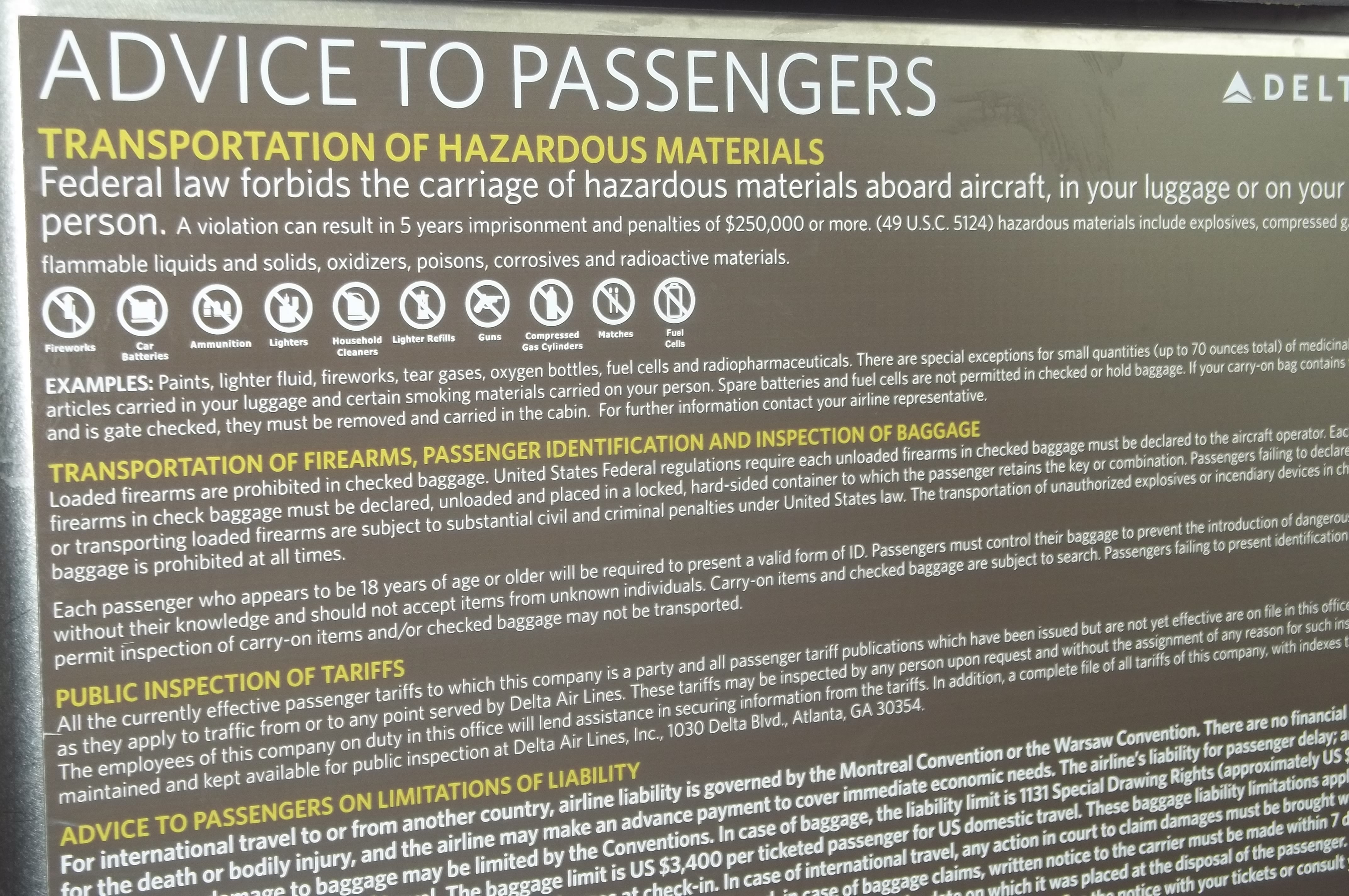If you travel by air as much as I do (that’s what Onsite Training requires), you’ve  seen the signs forbidding the transportation of hazardous materials aboard passenger aircraft, either in checked baggage or carry-on. The purpose of this article is to identify the source of those signs, summarize the requirements of the regulations, and provide additional sources of information for the harried traveler.
seen the signs forbidding the transportation of hazardous materials aboard passenger aircraft, either in checked baggage or carry-on. The purpose of this article is to identify the source of those signs, summarize the requirements of the regulations, and provide additional sources of information for the harried traveler.
The Hazardous Material Regulations of the Pipeline and Hazardous Materials Safety Administration (PHMSA) at 49 CFR 175.25 (Part 175 is specific to the transportation of HazMat by aircraft and is enforced by the Federal Aviation Administration or FAA) specify the requirements for an aircraft operator (aka: airline) to display information to its customers on what is forbidden in luggage but also to ensure that same information is presented to passengers and, to the best of their ability, ensure the air traveler understands it. To accomplish this, 49 CFR 175.25 requires two simultaneous methods of communication.
Display of notices:
The airline must prominently display notices that include, at a minimum, the following information:
Federal law forbids the carriage of hazardous materials aboard aircraft in your luggage or on your person. A violation can result in five years’ imprisonment and penalties of $250,000 or more (49 U.S.C. 5124). Hazardous materials include explosives, compressed gases, flammable liquids and solids, oxidizers, poisons, corrosives and radioactive materials. Examples: Paints, lighter fluid, fireworks, tear gases, oxygen bottles, and radio-pharmaceuticals.
There are special exceptions for small quantities (up to 70 ounces total) of medicinal and toilet articles carried in your luggage and certain smoking materials carried on your person. For further information contact your airline representative.

This notice must be legible and prominently displayed so it can be seen by passengers in the following locations used by the airline:
- Where it issues tickets.
- Where it checks baggage, and;
- It’s aircraft boarding areas.
Requiring the airline to display the information in the above-indicated areas doesn’t mean that anyone is going to read it. Therefore, §175.25 goes further to require the information be presented to passengers during ticket purchase and check-in.
Like this article? Subscribe to my Monthly Newsletter No marketing emails! |
Provide Information at Ticket Purchase and Flight Check-In:
- Airline must ensure that information on forbidden HazMat is presented at the point of ticket purchase.
- Or, if this is not practical, made available to passengers in another manner prior to the check-in process. (The requirements for providing information at check-in are addressed next).
- If the information is provided via the Internet:
- May be text or pictorial.
- Must be arranged so that the ticket purchase cannot be made until the passenger, or their agent, has indicated they have been presented and understand the HazMat in baggage restrictions. From §175.25(b):
…must be such that ticket purchase cannot be completed until the passenger, or a person acting on their behalf, has been presented with this information and indicated that they have understood the restrictions on hazardous materials in baggage.
We done? Nope, ’cause PHMSA and FAA require this information to be presented at check-in as well. The requirements differ depending on whether the check-in is done with or without the assistance of an airline representative.
- If check-in process is conducted remotely (e.g. Internet) or at the airport without assistance from a person (e.g. automated check-in kiosk):
- The airline must ensure that information on forbidden HazMat is presented to passengers.
- Information may be text or pictorial.
- Must be arranged so that check-in cannot be completed until the passenger, or their agent, has indicated they have been presented and understand the HazMat in baggage restrictions. From §175.25(c):
…must be such that the check-in process cannot be completed until the passenger, or a person acting on their behalf, has been presented with this information and indicated that they have understood the restrictions on hazardous materials in baggage.
- If the check-in process is not conducted remotely (e.g. at the airport with the assistance of an airline representative):
- Notification of permitted and forbidden HazMat in baggage may be completed through signage.
- Signage may be electronic or otherwise.
- Must be legible and prominently displayed.
Note that their is no specified content for the information presented at ticket purchase or check-in as their is for the notices displayed elsewhere.
For much more information about what is acceptable and what is not, refer to the website of the Federal Aviation Administration: PackSafe.
Contact me with any questions you may have about the transportation of hazardous materials by air, highway, vessel, or rail International and Domestic Daniels Training Services 815.821.1550 |
 Just one more example of the scope of the Hazardous Material Regulations. If they affect your flight to a holiday location, surely they impact your place of business. Contact me with questions about the HMR and the training required for HazMat Employees.
Just one more example of the scope of the Hazardous Material Regulations. If they affect your flight to a holiday location, surely they impact your place of business. Contact me with questions about the HMR and the training required for HazMat Employees.

